AMD Radeon HD 7990 Review: 7990 Gets Official
by Ryan Smith on April 24, 2013 12:01 AM EST- Posted in
- GPUs
- AMD
- Radeon
- Radeon HD 7000
- Tahiti
Compute
As always we'll start with our DirectCompute game example, Civilization V, which uses DirectCompute to decompress textures on the fly. Civ V includes a sub-benchmark that exclusively tests the speed of their texture decompression algorithm by repeatedly decompressing the textures required for one of the game’s leader scenes. While DirectCompute is used in many games, this is one of the only games with a benchmark that can isolate the use of DirectCompute and its resulting performance.
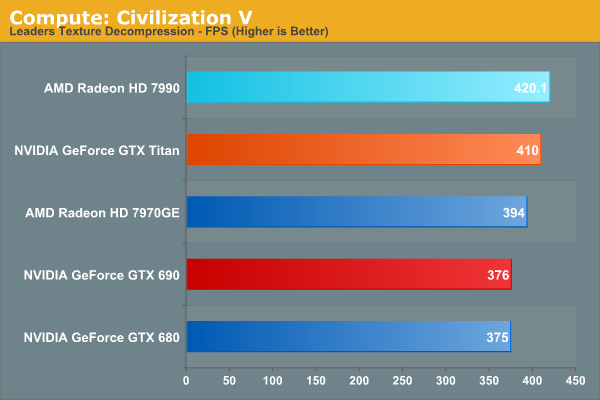
Civ V's texture compression routines are technically mutli-GPU capable, but multi-GPU scaling has never been particularly impressive here. So this test mostly reinforces what we already know about the Tahiti GPU being very capable in most DirectCompute workloads.
Our next benchmark is LuxMark2.0, the official benchmark of SmallLuxGPU 2.0. SmallLuxGPU is an OpenCL accelerated ray tracer that is part of the larger LuxRender suite. Ray tracing has become a stronghold for GPUs in recent years as ray tracing maps well to GPU pipelines, allowing artists to render scenes much more quickly than with CPUs alone.
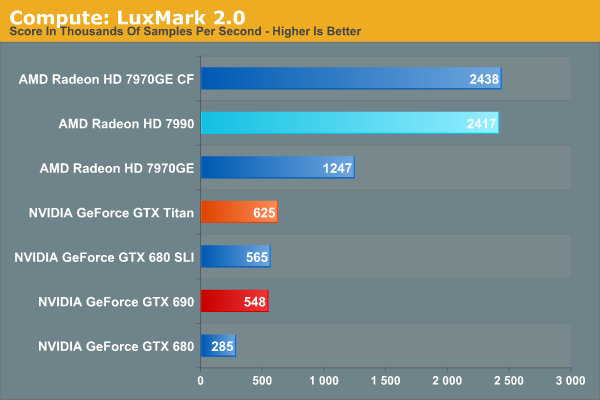
The 7990 isn’t billed as a compute product, but that doesn’t mean it’s at all weak at compute. On the contrary, as LuxMark doesn’t hit the ROPs hard the 7990 has no trouble staying under its 375W target, allowing it to sustain 1000MHz indefinitely. As a result the 7990 takes AMD’s compute advantage and runs with it. The 7990 is a bit more 2x the cost of a 680, but it’s 8.5x faster. Even against GTX Titan the difference is just short of 4x; NVIDIA simply doesn’t do well in our OpenCL tests.
Our 3rd benchmark set comes from CLBenchmark 1.1. CLBenchmark contains a number of subtests; we’re focusing on the most practical of them, the computer vision test and the fluid simulation test. The former being a useful proxy for computer imaging tasks where systems are required to parse images and identify features (e.g. humans), while fluid simulations are common in professional graphics work and games alike.
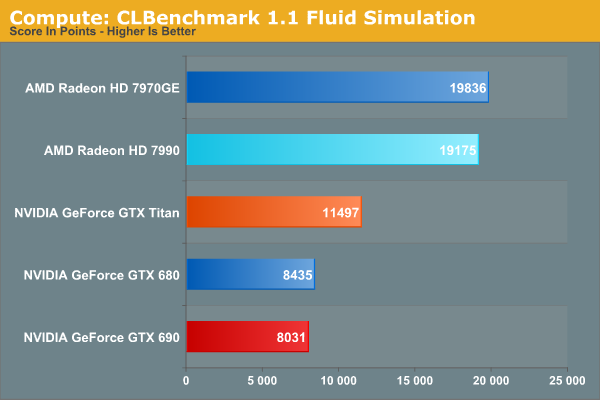
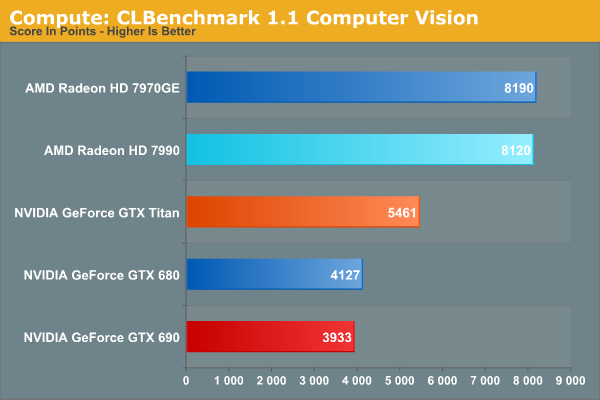
These two CLBenchmark sub-tests aren’t multi-GPU capable, so the performance of the 7990 is essentially dictated by its first GPU. All that means however is that the 7990 is once again at the top of the charts, well ahead of NVIIDA’s other cards and beating Titan by 50%-100%. At the same time this is a good reminder that not every compute task scales well across multiple GPUs, which is why single-GPU products still have a strong place in the GPU compute world.
Moving on, our 4th compute benchmark is FAHBench, the official Folding @ Home benchmark. Folding @ Home is the popular Stanford-backed research and distributed computing initiative that has work distributed to millions of volunteer computers over the internet, each of which is responsible for a tiny slice of a protein folding simulation. FAHBench can test both single precision and double precision floating point performance, with single precision being the most useful metric for most consumer cards due to their low double precision performance. Each precision has two modes, explicit and implicit, the difference being whether water atoms are included in the simulation, which adds quite a bit of work and overhead. This is another OpenCL test, as Folding @ Home is moving exclusively OpenCL this year with FAHCore 17.
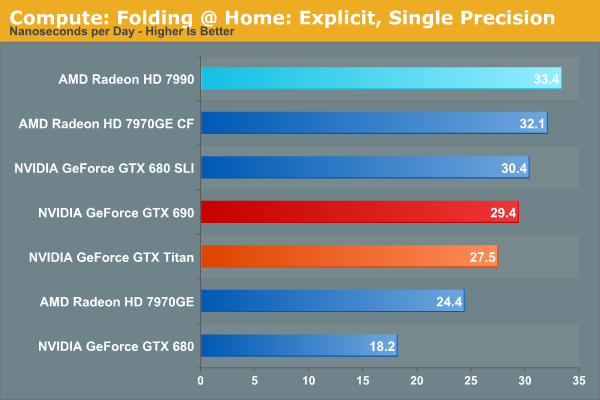
Only FAHBench’s explicit mode is multi-GPU capable, and even then the scaling to multiple GPUs isn’t great. Still, it’s enough to help the 7990 take the top spot on this benchmark, even with NVIDIA’s latest drivers slightly closing the gap. What’s particularly interesting here though is that the 7990 is faster than the 7970GE CF, and that’s not a fluke in our results. The 7990 should by all means be at least a bit slower, and more if throttling kicks in. It looks like we’re seeing one of those rare cases where the GPUs are benefitting from the presence of the PLX bridge, as going through the relatively close-by bridge is faster than in a two-card setup where the GPUs would have to communicate through the CPU/Northbridge. However this is the only time we see such an advantage; in most other compute scenarios – let alone gaming – the PLX bridge won’t have any kind of notable impact.
Wrapping things up, our final compute benchmark is an in-house project developed by our very own Dr. Ian Cutress. SystemCompute is our first C++ AMP benchmark, utilizing Microsoft’s simple C++ extensions to allow the easy use of GPU computing in C++ programs. SystemCompute in turn is a collection of benchmarks for several different fundamental compute algorithms, as described in this previous article, with the final score represented in points. DirectCompute is the compute backend for C++ AMP on Windows, so this forms our other DirectCompute test.
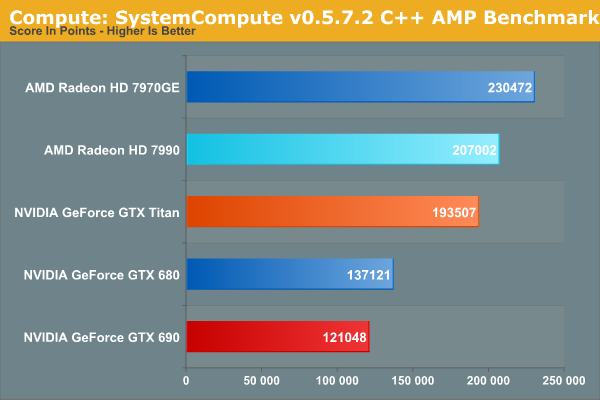
SystemCompute isn’t multi-GPU capable, so once again we’re leaning on the 7990’s first GPU. To that end we find the 7990 in second place, but we also see the 7790 clearly trailing the 7970GE by more than we’ve seen in our other compute benchmarks. SystemCompute does do a lot of I/O, so if FAHBench is the ideal case for showcasing the benefits of the PLX bridge in GPU to GPU I/O, then SystemCompute is good case for showcasing the drawbacks of the PLX bridge, mainly the higher I/O latency. It’s not enough to cripple the 7990 – it’s faster than the GTX Titan even here – but it does cost the 7990 some performance.










91 Comments
View All Comments
A5 - Wednesday, April 24, 2013 - link
People use OpenCL all the time. You have no idea what you're talking about.bigboxes - Wednesday, April 24, 2013 - link
Then you might as well had a double 7990 in your fantasy world.Freakie - Wednesday, April 24, 2013 - link
It's already long been discussed, Nvidia's drop in Compute performance. Nvidia decided to focus their consumer cards on what they are meant for, gaming, and not overly engineer their GPU's to be heavy hitters for compute performance. There a number of instances where the GTX 580 is better at compute than the 680 is. As Ryan mentioned, the price AMD pays for those gains is in much higher power consumption which of course makes it harder for budget minded buyers to get into AMD. Having to spend an extra $30 on your PSU makes a big difference in a $600 build when you're trying to stretch every dollar and Nvidia has shifted to focus quite heavily in the budget build areas and this is one of the ways they are doing it.And no, the synthetics say absolutely nothing about the longevity of a card. Longevity of a card is always the support that the GPU developer (AMD/Nvidia) and game developers give it. Software makes or breaks a GPU's ability to be useful, which is why we have a plethora of Driver updates and game patches and why things are programmed using unified tools and languages and why new GPU's keep certain features of their architecture throughout many generations. There is reason why Nvidia 7xxx and 6xxx series GPU's have suddenly become insufficient when they, at least the 79xx, lasted a VERY long time. Hardware shifted too far away fundamentally from those older cards and so software (games) made for newer cards simply did not have the hardware architecture of older cards in mind and now the utterly fail in some games. If you want longevity in your GPU, then just buy the latest architecture from whichever company you prefer, make sure it's not a rebranded version of a previous series, and you'll get the maximum lifespan out of it.
lmcd - Friday, April 26, 2013 - link
It's pretty irrelevant for this card given that the 7990 posted one significant win over the 7970...xTRICKYxx - Wednesday, April 24, 2013 - link
Love the review. With having to compete with the GTX 690 and Titan, this is the correct response AMD provided. I think it should be priced at $849 or something around there to sway buyers.On paper the 7990 is faster than all of Nvidia's products overall, but its high power consumption may be a turn off for some.
On another note, 320.00 is an awesome driver release.
abhishek6893 - Wednesday, April 24, 2013 - link
AMD 7990 is much faster than NVIDIA's TITAN.CiccioB - Wednesday, April 24, 2013 - link
Yessss.... It also uses twice the power though...Beavermatic - Wednesday, April 24, 2013 - link
LOL.... considering the 7990 is a dual-gpu card, I would hope its faster than a Titan, given titan is a single-gpu powerhouse. But only marginally, which shows how powerful the Titan really is.shing3232 - Wednesday, April 24, 2013 - link
where could i get AMD CCC 13.5?Sancus - Wednesday, April 24, 2013 - link
It would be nice if you guys got one of the PNK321 3840x2160 monitors and tested it with this card(and some other setups like CF 7970s, maybe Titans using borderless windowed...). Right now AMD has the only solution for fullscreen 4k gaming at 60hz because this monitor shows up as two displays when you run it at 60hz and thus without 2x1 Eyefinity you can't get a single display surface. Nvidia's only comparable solution is Mosaic but it's only for Quadro cards.Anyway, it would be nice to find out whether 3840x2160 gaming is viable with the 7990.